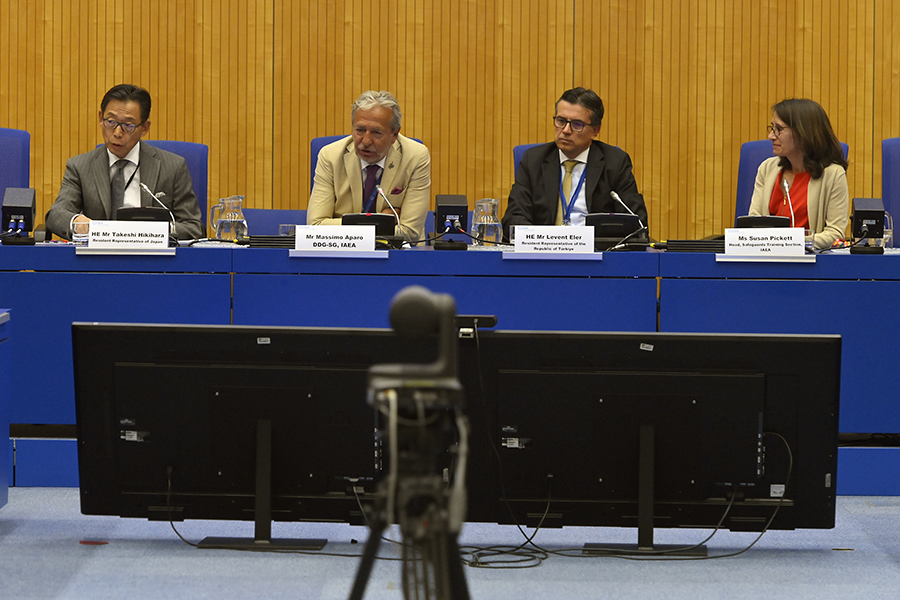September 2023
By Daryl G. Kimball
More than 30 years ago, citizen activists and independence leaders in Kazakhstan forced Russia to halt nuclear testing, prompting the United States, under pressure from U.S. activists and members of Congress, to adopt a nine-month testing halt in 1992. On July 3, 1993, U.S. President Bill Clinton extended that moratorium and announced plans to pursue negotiations on a global, comprehensive test ban treaty. After more than 2,000 deadly nuclear test explosions worldwide since 1945, including 715 Soviet tests and more than 1,030 U.S. tests, these developments marked the beginning of the end of the nuclear testing era.
 Since the conclusion of the 1996 Comprehensive Test Ban Treaty (CTBT), which has been signed by 186 countries, nuclear testing has become taboo. All CTBT states agree that the treaty prohibits “any nuclear weapons test explosion, or any other nuclear explosion” no matter what the yield. The Preparatory Commission for the Comprehensive Nuclear-Test-Ban Treaty Organization operates the fully functional International Monitoring System (IMS) to detect and deter cheating. Most nuclear-armed states that have not signed or not ratified the CTBT, including China, India, Israel, and Pakistan, are observing nuclear testing moratoria.
Since the conclusion of the 1996 Comprehensive Test Ban Treaty (CTBT), which has been signed by 186 countries, nuclear testing has become taboo. All CTBT states agree that the treaty prohibits “any nuclear weapons test explosion, or any other nuclear explosion” no matter what the yield. The Preparatory Commission for the Comprehensive Nuclear-Test-Ban Treaty Organization operates the fully functional International Monitoring System (IMS) to detect and deter cheating. Most nuclear-armed states that have not signed or not ratified the CTBT, including China, India, Israel, and Pakistan, are observing nuclear testing moratoria.
Although it has not yet formally entered into force, the CTBT is one of the most successful agreements in the long history of nuclear arms control and nonproliferation. Without the option to conduct nuclear tests, it is more difficult, although not impossible, for states to develop, prove, and field new warhead designs.
But as with other critical nuclear risk reduction, nonproliferation, and arms control agreements, the CTBT is under threat due to inattention, diplomatic sclerosis, and worsening relations between nuclear-armed adversaries.
After senior U.S. officials in the Trump administration in 2020 callously discussed having the United States resume nuclear testing to try to intimidate China and Russia, the Biden administration made it clear in 2021 that “the United States supports [the CTBT] and is committed to work to achieve its entry into force.”
But the Biden administration has done none of the outreach and education that will be necessary to secure treaty ratification by the Senate. Given that the United States has not conducted a nuclear test in more than 30 years and has no technical, military, or political reason to resume testing, the national security case for ratification and for strengthening the barriers against testing by others is even stronger than when the treaty was last considered by the Senate in 1999.
One salient issue that needs addressing is the recent U.S. charge that “during the 1995-2018 timeframe, Russia probably conducted nuclear weapons-related tests” at its former test site at Novaya Zemlya. The assessment provides no evidence and does not claim that the Russian activities were militarily significant. Russia, which ratified the CTBT, has denied the charge and repeatedly pointed to the U.S. failure to ratify the treaty.
China, Russia, and the United States continue to engage in weapons-related activities at their former nuclear testing sites. Although the IMS is operational and far more effective than originally envisioned, very low-yield nuclear test explosions still can be difficult to detect without on-site inspections, which will not be in place until after the treaty’s entry into force.
To address concerns about clandestine activities at former test sites, CTBT states-parties should adopt voluntary confidence-building measures designed to detect and deter possible low-level, clandestine nuclear testing by the major nuclear powers. In a positive move, Jill Hruby, administrator at the U.S. National Nuclear Security Administration, announced in June that her agency is “open to working with others to develop a regime that would allow reciprocal observation with radiation detection equipment at each other’s subcritical experiments to allow confirmation that the experiment was consistent with the CTBT.”
Meanwhile, Russia may be on the verge of further nuclear nonproliferation sabotage. Russian officials acknowledge reports that they are considering the self-defeating option of “unratifying” the CTBT to achieve symmetry with Washington in all areas of nuclear policy, but say no official decisions have been made.
Contrary to the perceptions of extremists in Moscow, “unratification” would not create leverage for Russia vis-à-vis the collective West. Rather, it would undermine Russia’s already shaky nuclear nonproliferation standing, alienate non-nuclear-weapon states, and set back the very popular and heretofore very successful CTBT regime. In 2016, Russia joined the United States and other members of the UN Security Council in supporting Resolution 2310, which strongly reaffirms support for the CTBT, and a statement from its five permanent members pledging that they would not take any action that would “defeat the object or purpose of the treaty.”
As diplomats from CTBT signatory states gather this month for the next conference on facilitating the CTBT’s entry into force, more energetic strategies must be considered not only to advance the treaty, but to strengthen the de facto norm against testing.





 The results of the first preparatory committee meeting for the 11th NPT Review Conference underscored deep fissures over the implementation of key treaty obligations, differences between nuclear-weapon states and non-nuclear-weapon states over disarmament and deterrence, and simmering disputes about nuclear weapons sharing arrangements.
The results of the first preparatory committee meeting for the 11th NPT Review Conference underscored deep fissures over the implementation of key treaty obligations, differences between nuclear-weapon states and non-nuclear-weapon states over disarmament and deterrence, and simmering disputes about nuclear weapons sharing arrangements.